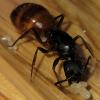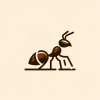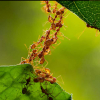- Formiculture.com
- Forums
- Gallery
- Members
- Member Map
- Chat

Alates- all male
Started By
Polyacanthus
, Jun 27 2023 7:09 PM
10 replies to this topic
#1
 Offline
-
Posted June 27 2023 - 7:09 PM
Offline
-
Posted June 27 2023 - 7:09 PM
Wondering if this is normal? I have a colony of Formica pallidefulva that produced a bunch of alates for the first time this spring (I think around 30) and they are all male. What's the scoop?
#2
 Offline
-
Posted June 27 2023 - 7:15 PM
Offline
-
Posted June 27 2023 - 7:15 PM
Usually, males are produced more and I think they take less energy to produce so it seems normal. How big is your colony?
- antsriondel likes this
Interested buying in ants? Feel free to check out my shop!
Feel free to read my journals, like this one.
Wishlist:
Atta sp (wish they were in CA), Crematogaster cerasi, Most Pheidole species
#3
 Offline
-
Posted June 27 2023 - 7:20 PM
Offline
-
Posted June 27 2023 - 7:20 PM
Yeah that's normal
"I am here on Earth, and I am only a speck of sand in the desert, a blade of grass in a field. I am no greater than any one of these busy ants who build for each other's comfort. " - King Solomon
Currently keeping: Myrmecocystus Depilis, Pogonomyrmex Rugosus
Wishlist: Camponotus Ocreatus
#4
 Offline
-
Posted June 28 2023 - 8:13 AM
Offline
-
Posted June 28 2023 - 8:13 AM
To add onto this, in nature some colonies will produce only male alates, others only females and others both sexes.
- Polyacanthus and OhNoNotAgain like this
My journals:
Polyergus Mexicanus: https://www.formicul...gs/#entry175528
Lasius minutus: https://www.formicul...cs/#entry174811
Lasius latipes: https://www.formicul...gs/#entry206449
General acanthomyops journal: https://www.formicul...yops-with-eggs/
Polyergus Mexicanus: https://www.formicul...gs/#entry175528
Lasius minutus: https://www.formicul...cs/#entry174811
Lasius latipes: https://www.formicul...gs/#entry206449
General acanthomyops journal: https://www.formicul...yops-with-eggs/
#5
 Offline
-
Posted June 28 2023 - 10:30 AM
Offline
-
Posted June 28 2023 - 10:30 AM
My Camponotus barbaricus are doing the exact same this year.
They have previously produced queens but right now there are only male alates (and like a LOT of them).
Not sure why they're doing it, but then not much i can do about it either.
We should respect all forms of consciousness. The body is just a vessel, a mere hull.
Welcome to Lazy Tube - My Camponotus Journal
#6
 Offline
-
Posted June 28 2023 - 7:38 PM
Offline
-
Posted June 28 2023 - 7:38 PM
To add onto this, in nature some colonies will produce only male alates, others only females and others both sexes.
Interesting, I didn't know about this. In these cases does it change from year to year, depending on conditions? Or do some colonies just always produce the same thing?
#7
 Offline
-
Posted June 28 2023 - 7:39 PM
Offline
-
Posted June 28 2023 - 7:39 PM
Usually, males are produced more and I think they take less energy to produce so it seems normal. How big is your colony?
Hard to say but I'd guess around 300.
#8
 Offline
-
Posted June 29 2023 - 6:05 AM
Offline
-
Posted June 29 2023 - 6:05 AM
That would make this one of, if not THE, most successful pallidefulva colonies recorded on here. Please don’t leave them in obscurity.
"The ants are a people not strong, yet they prepare their meat in the summer." Prov. 30:25
Keep ordinary ants in extraordinary ways.
Keep ordinary ants in extraordinary ways.
#9
 Offline
-
Posted June 29 2023 - 7:58 AM
Offline
-
Posted June 29 2023 - 7:58 AM
To add onto this, in nature some colonies will produce only male alates, others only females and others both sexes.
Interesting, I didn't know about this. In these cases does it change from year to year, depending on conditions? Or do some colonies just always produce the same thing?
Probably is based on something like that. I would think that its an adaptation to prevent inbreeding.
#10
 Offline
-
Posted June 29 2023 - 9:59 AM
Offline
-
Posted June 29 2023 - 9:59 AM
To add onto this, in nature some colonies will produce only male alates, others only females and others both sexes.
Interesting, I didn't know about this. In these cases does it change from year to year, depending on conditions? Or do some colonies just always produce the same thing?
Some ants have a supergene that, aside from a lot of other things, makes the entire colony behave as if it had a specific biological sex, which means they either produce only male alates or only female alates (they may still produce a small fraction of gynanders or workers with queenlike features).
Some ants on the other hand use male production as a quick way of getting their genes back into the genepool before anything can happen to the colony. Males are much cheaper to produce than queens, so these species have a year or two of males first and only enter production of young queens later. They may also switch to producing only/mostly males if they're having a bad year.
Ant sex determination works different from humans. In ants it works fully decentralized on a cellular level, which means each individual cell has its own biological sex and inherits it onto its decentants - this can produce things like gynanders (individuals that are half-female and half-male) because the individual cells don't communicate with each other on this matter.
Usually ant males are haploid (they only have one set of chromosomes) and workers/queens are diploid (they have two sets of chromosomes) but there may be weird coincidences and genetic accidents where cells can switch their biologocal sex despite being diploid, or cells may loose one set of chromosomes during mitosis. It may also happen that two egg cells stick together, get encased in one egg and proceed to develop into a single individual ant that is made from one fertilized (female) and one unfertlized (male) cell.
In humans and other mammals sex determination works in a semi-centralized top-down way, which means various genes and hormone glands drive the development of all cells and tissues across the entire body and tell them what to develop into (i think in humans it's 21 genes responsible for the major determinations throughout a person's lifetime, most stuff happens during childhood and youth) - this makes the development of gynanders impossible but instead turns biological sex into a slide between two polar points and opens the door for literally every imaginable in-between state and beyond to naturally emerge, including XY women and XX men (because apparently it is literally one gene that kicks off the entire process and this gene can jump from the Y-Chromose to the X-Chromosome during meiosis, resulting in a "male" X-chromosome and a "female" Y-chromosome - it may also become damaged and non-functional, so the body switches to the "standard" female recipe and proceeds to ignore most of the Y-chromosome's information).
And beyond that, it's even more complicated because biological sex may not even correspond with perceived sex identity, which probably also has its root cause in this whole hypercomplicated semi-centralized step-by-step top-down genetic approach, just in a way we haven't yet understood.
And even that is still not touching on the REALLY complicated rare stuff like chimera resorption where one fetus absorbs their twin sibling during pregnancy, which can result in a human individual with two genetic fingerprints, depending on when they sibling got absorbed. Like a young girl could have immune cells with a completely different DNA in their nucleus, featuring an XY setup, because she absorbed her twin brother whos tissue is now producing her blood (it doesn't work with red blood cells because in mammals and birds* those don't have a nucleus). So she doesn't just have two different genetic fingerprints, her blood fingerprint is actually that of a male.
Yes, this stuff is REALLY complicated and despite one and a half centuries worth of endevaours into genetics we have so far mostly just worked out the basics.
*Birds do sex determination the ant way though, so they can actually produce gynanders but not really any in-between states.
Edited by Serafine, June 29 2023 - 10:21 AM.
- Polyacanthus likes this
We should respect all forms of consciousness. The body is just a vessel, a mere hull.
Welcome to Lazy Tube - My Camponotus Journal
#11
 Offline
-
Posted July 4 2023 - 8:19 PM
Offline
-
Posted July 4 2023 - 8:19 PM
That would make this one of, if not THE, most successful pallidefulva colonies recorded on here. Please don’t leave them in obscurity.
https://www.formicul...e-5#entry228819
1 user(s) are reading this topic
0 members, 1 guests, 0 anonymous users




















